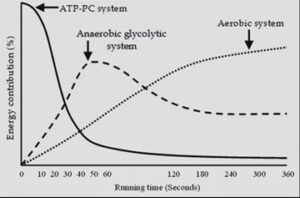
Benefits:
The next point in the Movement realm is what many know as Cardio or Aerobic work (but can be more than just that, as you’ll see soon).
Benefits of Conditioning work:
- Improve cardiovascular function
- Improve insulin sensitivity (can prevent type 2 diabetes)
- Decrease visceral (deep tissue) fat
- Improve metabolic function (teach your body to burn fat more efficiently)
I would encourage you to think about Conditioning work less about burning calories and more about improving your work capacity. You will, of course, burn calories whilst doing any training. When you train at intensity, your metabolism can also be raised for a prolonged period afterward. Calories In v. Calories Out is a part of how you will achieve fat loss, if that is your goal. But your nutrition will have the biggest effect on this. Based on my experience from observing clients over the years and my own work, I would estimate it at 70-80% nutrition and 20-30% exercise, in terms of the effect on weight loss.
Actions:
At least 2 x per week, do a 20-60 minute Conditioning workout
Notes:
Your Conditioning workouts are going to improve your work capacity (which you may just call your fitness, although I consider fitness to be more than just this). This involves improving the efficiency of your energy systems. There are 3 main energy systems in your body:
- The ATP / Creatine Phosphate System (also known as Alactic Anaerobic)
- The Glycolytic System (also known as Lactic Anaerobic)
- The Oxydative System (or Aerobic)
These are all pathways for your body to provide energy for work. You use all 3 at all times, but depending on the length and intensity of the work you are doing, you will predominantly use one over the others (see the table below to see how much each contributes for different time frames).

Time should be spent working on all 3 energy pathways, but we would prioritise developing the Oxydative System first. This can be described as “building a good Aerobic Base”. Developing a great Aerobic System brings a whole host of positive health benefits as well as improving your capacity to recover from other types of training.
Typical examples of Conditioning Workouts would be:
- Interval Training – This is an efficient way of training that produces great results. It just means performing short periods of higher intensity work, followed by rest periods. This can be used for all 3 energy pathways and could range from Sprints for the very fit (High Intensity Interval Training or HIIT) to Brisk walking at the other end of the scale. The idea is just to work harder during the work period than you would do if you had to hold that effort for the length of the whole workout. For people who are showing signs of illness/stress/fatigue, intensity should be reduced at first. Allowing them to recover, whilst implementing points from the other areas of Nutrition and Mental Fitness, will enable them to increase intensity in the future. Examples: Aerobic Intervals – 5 x 500m Row with 2 min Rests, Anaerobic Intervals – 8 x 10 sec Sprint on Assault Bike with 2:30 Rests.
- Metabolic Conditioning (or Met-Cons for short) – Made popular in recent years by CrossFit, this type of workout breaks the mould of traditional conditioning training by incorporating weight training movements or bodyweight exercises into the workouts alongside more traditional conditioning exercises like rowing, running or skipping. Workouts are measurable and repeatable, so it’s a good way to be able to track your fitness progress. They are also varied in length of time, structure and type of exercise, which keeps it interesting. However, they are traditionally done at high intensity, which might not be the best place to start for people that are less experienced, feeling tired/stressed or showing signs of illness. Those people could still do CrossFit style workouts but should decrease the intensity significantly and the exercise selection should reflect their experience and abilities.
- Steady State Training – There is still a place for going for a longer run/swim/row/bike etc. This could be used to work on your endurance (maybe preparing you for a longer race like a Half or Full Marathon) or testing your work capacity (5km Run/2km Row etc.)
- Playing a Sport – any sport where you will be running around or getting out of breath playing it, is a great way to work on your Conditioning. It keeps your mind occupied and makes the exercise fun.